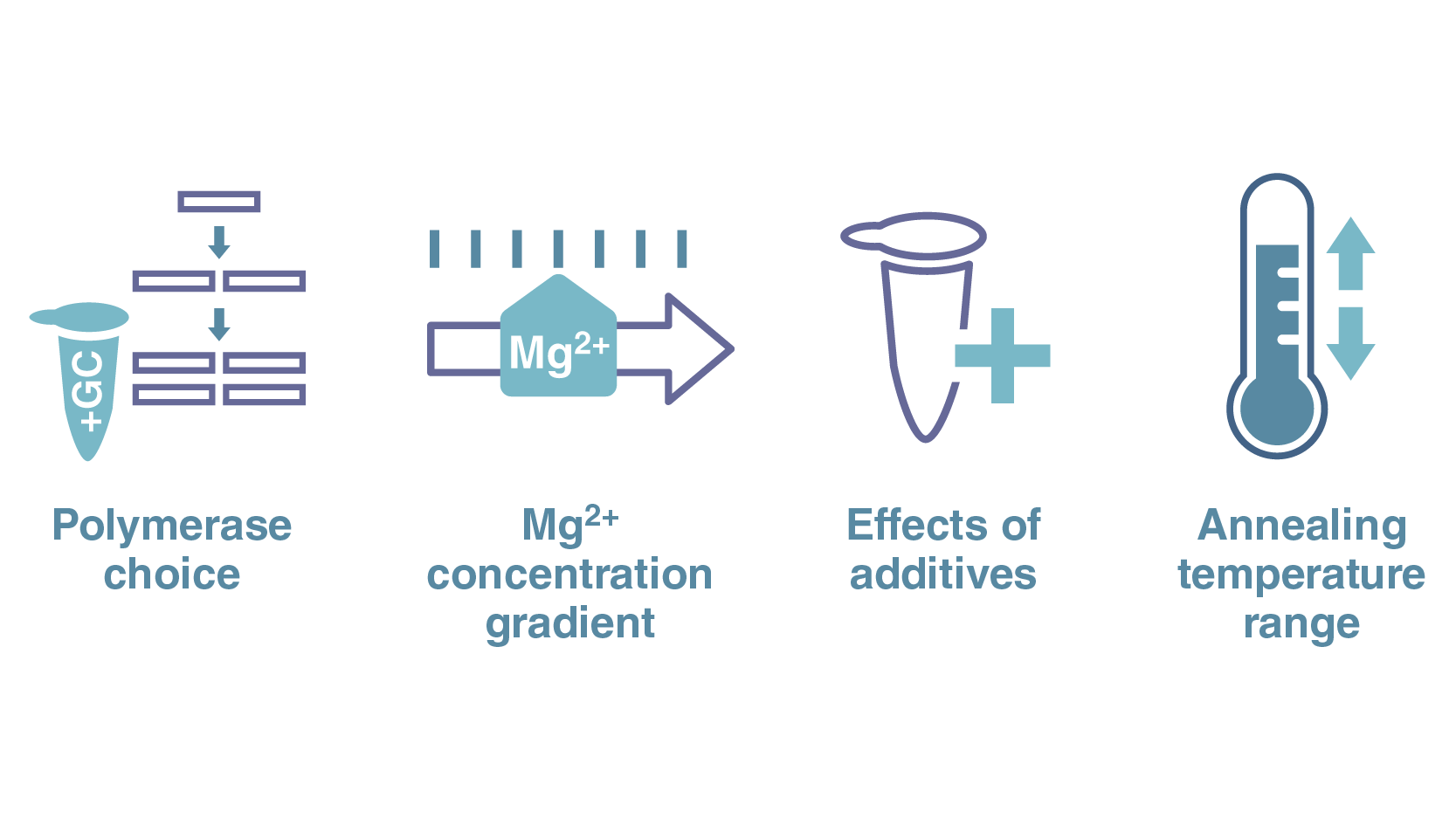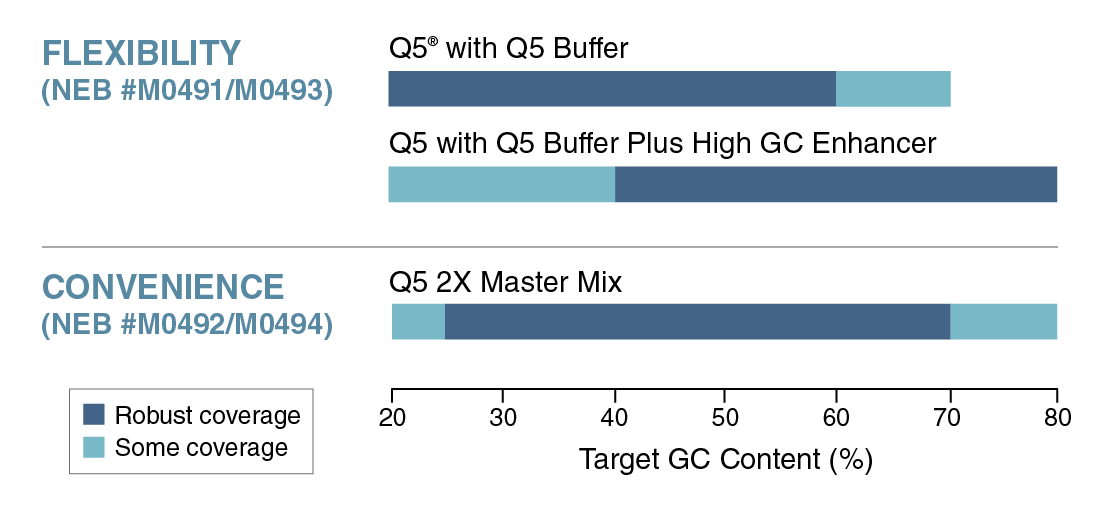
Four tips for PCR amplification of GC-rich sequences
Posted on Thursday, September 15, 2022
By
Topic: Tips for the lab
Are you having trouble amplifying those tricky GC-rich regions? Here are some tips from NEB scientists on how to troubleshoot your GC-rich PCR.
First, let’s define what we’re talking about here – a GC-rich template refers to a DNA sequence where 60% (or greater) of the bases present are G (guanine) or C (cytosine). Only 3% of the human genome is GC-rich, but these regions are often found in the promoters of genes, particularly housekeeping and tumor suppressor genes.
Why can these regions be so challenging to amplify? There are three hydrogen bonds between a G-C base pair and only two between an A-T base pair. This makes a G-C bond more thermostable; it requires more energy to break the three hydrogen bonds. GC-rich regions are also ‘bendable’, readily forming secondary structures like hairpins.

If you see a blank gel or a DNA smear when trying to amplify a GC-rich template, consider your reagents (polymerase choice, Mg2+ concentration, and the effects of various additives) and the annealing temperature of your reaction.
While master mix formats are ideal for convenience and minimizing pipetting errors, if you’re troubleshooting a GC-rich PCR, there is very little user setup flexibility. For this reason, some master mixes are specifically tailored to amplify GC-rich sequences (e.g., OneTaq® Hot Start 2X Master Mix with GC Buffer). Alternatively, if you forego the master mix and use a standalone polymerase, it is easier to tweak the reaction components.
(1) Polymerase choice
Choosing the right polymerase to amplify GC-rich regions is critical. Taq polymerase is the most common polymerase used for PCR, but now, many polymerases have been specifically optimized to amplify GC-rich sequences.Insight
Polymerases can sometimes stall at the complex secondary structures that tend to form when GC-rich stretches fold onto themselves. These structures block the polymerase and result in shorter/incomplete molecules. GC-rich regions also resist denaturation, making it difficult for primers to anneal. And the primers used to amplify GC-rich templates tend to form dimers. Changing the polymerase can sometimes overcome these challenges.Tip
Some polymerases are supplied with a GC Enhancer that contains additives that help to inhibit secondary structure formation and increase primer stringency.
OneTaq DNA Polymerase (NEB #M0480) is twice the fidelity of Taq polymerase and is ideal for routine or GC-rich PCR. It was developed with both standard and GC buffers to provide high yield and specificity for particularly difficult amplicons. Up to 80% GC content can be amplified by adding the OneTaq High GC Enhancer to the GC buffer.
Likewise, Q5® High-Fidelity DNA Polymerase (NEB #M0491) is more than 280 times the fidelity of Taq and is ideal for long or difficult amplicons, including GC-rich DNA. Amplification can be improved on GC-rich sequences by adding Q5 High GC Enhancer to the buffer. The figure below shows the robust performance of the Q5 High-Fidelity 2X Master Mix (NEB #M0492) on 25 to 70% GC content. In comparison, the standalone polymerase provides flexibility to amplify a wider range of GC content and can give robust performance up to 80% GC, thanks to the GC enhancer supplied with the polymerase.

Q5 formats allow robust amplification of a broad range of targets
On a side note – if you are working with blood samples, we have just released our Q5 Blood Direct 2X Master Mix (NEB #M0500), which works well for amplicons up to 75% GC content. The buffer delivers increased resistance to inhibitors in the blood. You can fast-track your workflow by amplifying targets directly from dried blood spots or up to 30% whole human blood, skipping the DNA purification step.
![]()
(2) Mg2+ concentration
Magnesium is a cofactor in PCR. It is required for the enzymatic activity of the polymerase and enables the addition of dNTPs. It is also essential for primer binding. Too much MgCl2 can lead to non-specific primer binding, which will be viewed on an agarose gel as multiple DNA bands. On the other hand, too little MgCl2 will cause reduced polymerase activity leading to weak or no amplification.
Insight
Mg2+ has a critical role in the polymerization reaction. It binds to a dNTP at its α-phosphate group, allowing removal of the β and gamma phosphates. It also helps catalyze the phosphodiester bond between the remaining dNMP and the 3’ OH of the adjacent nucleotide. Mg2+ facilitates primer binding by binding to the negatively charged phosphate ion, reducing electrostatic repulsion between two DNA strands. MgCl2 is typically supplied in the buffer that accompanies the polymerase. For standard PCR reactions, 1.5 to 2 mM MgCl2 is the most used concentration. However, DNA templates with high GC content may require altering the concentration.Tip
If you suspect that the Mg2+ concentration is the cause of a failed PCR, we advise you to try a concentration gradient of MgCl2 to find that sweet spot where you can eliminate non-specific binding while still maximizing your yield. Try 0.5 mM increments between 1.0 and 4 mM.
![]()
(3) Effects of additives
Many known additives impact the amplification of GC-rich regions. They work by either:
- reducing secondary structures, which increases amplification of your target, or
- reducing non-specific priming and the amplification of off-target DNA.
Insight
• DMSO, Glycerol and Betaine reduce secondary structures that can inhibit the polymerase.
• Formamide and Tetramethyl ammonium chloride increase the primer annealing stringency, which increases specificity.
• 7-deaza-2′-deoxyguanosine is a dGTP analog that can improve the PCR yield of GC-rich regions, although it does not stain well with ethidium bromide.
Tip
If you don’t know the cause of your poor amplification, you might not know which of these additives will work the best. It is laborious to test them all using various concentration gradients for each.
New England Biolabs® has formulated two polymerases with optimized GC Enhancers (discussed above in the polymerase section) that contain various GC-rich PCR enhancing additives: OneTaq DNA Polymerase (NEB #M0480), and Q5 High-Fidelity DNA Polymerase (NEB #M0491).
![]()
(4) Annealing temperature
Multiple bands on a gel are an indication of non-specific binding. You might need to increase your annealing temperature (Ta). If you’re getting no product at all, perhaps the annealing temperature is too high.
Insight
The Tm is the primer melting temperature, and Ta is the primer annealing temperature. It’s typical to design primers with a Tm of between 50 and 72°C, and the primer annealing temperature (Ta) should be about 5°C lower than the Tm.
The Tm is an estimate based on the stability of the interaction between the primer and template. There is typically an excess of primer and limited template ssDNA. The Tm is the temperature at which there is an equilibrium between the free and bound primer and template.
As mentioned above, a G-C pair has three hydrogen bonds, and an A-T pair has two hydrogen bonds. Based on this, you can predict that a higher proportion of G-C pairs would require a higher temperature to disassociate them. Generally, the higher the Ta, the more specific primer binding will be, but less product may be formed (so more PCR cycles might be required). But if the annealing temperature is too high, the primer will have reduced template hybridization.
Tip
To prevent non-specific amplification, you can try a higher annealing temperature (Ta). This can also help separate secondary structures. Try a temperature gradient or use a higher annealing temperature for the first few PCR cycles.
The NEB web tool Tm Calculator can help you evaluate the best Ta for your PCR reaction; it takes into account the enzyme and buffer you intend to use.
It’s important to keep in mind that there isn’t a universal solution that works well for all GC-rich amplicons. The impact of changing any parameter outlined above will be target specific, so what works for one amplicon may not work for another (e.g., you may need 10% OneTaq GC Enhancer for one target but 20% for another). You will need to optimize for each target.
Good luck! And don’t forget, if you need help amplifying a GC-rich target, please get in touch with our technical support specialists.
NEB will not rent, sell or otherwise transfer your data to a third party for monetary consideration. See our Privacy Policy for details. View our Community Guidelines.
Products and content are covered by one or more patents, trademarks and/or copyrights owned or controlled by New England Biolabs, Inc (NEB). The use of trademark symbols does not necessarily indicate that the name is trademarked in the country where it is being read; it indicates where the content was originally developed. See www.neb.com/trademarks. The use of these products may require you to obtain additional third-party intellectual property rights for certain applications. For more information, please email busdev@neb.com.
Don’t miss out on our latest NEBinspired blog releases!
- Sign up to receive our e-newsletter
- Download your favorite feed reader and subscribe to our RSS feed
Be a part of NEBinspired! Submit your idea to have it featured in our blog.



